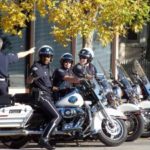 With the vast amount of media potential today, it is easy for out-of-line police to be caught on tape and exposed to an international audience. However, most people want to believe that these instances are very few and far between. In general, we picture our St. Petersburg police to be upholders of the law, paragons of morality. Unfortunately, these men and women in uniform are only human and they do make mistakes. Tempers can become heated when adrenaline is pumping and lives are being threatened, which can lead a police officer to act outside of what is deemed acceptable. So, when are police allowed to act with force? When can they take it beyond a shouting match to something potentially brutal? When are they allowed to pull a weapon?
With the vast amount of media potential today, it is easy for out-of-line police to be caught on tape and exposed to an international audience. However, most people want to believe that these instances are very few and far between. In general, we picture our St. Petersburg police to be upholders of the law, paragons of morality. Unfortunately, these men and women in uniform are only human and they do make mistakes. Tempers can become heated when adrenaline is pumping and lives are being threatened, which can lead a police officer to act outside of what is deemed acceptable. So, when are police allowed to act with force? When can they take it beyond a shouting match to something potentially brutal? When are they allowed to pull a weapon?
It should be pointed out that rarely do law enforcement officers have need for force. In a study from the early-2000s, it was reported “force” was only used in as few as one percent of all call. In this instance, the term is defined as “an amount of effort required by police to ensure compliance of a subject endangering himself, the police, or the general public.” It is reasonably expected that a police officer will use only as much force as necessary to control an incident. Though there is no universal rule, most police units have a set of guidelines in place to help officers determine when to take physical action against a subject.
Mere Presence. In the vast majority of cases, the presence of a police officer(s) is enough to deter a person, or group of people, from acting out. Verbal exchanges remain unheated and mutually respectful. A great example of this is a routine Saint Petersburg traffic stop, in which a police officer explains why the person is being pulled over, documents are exchanged, a ticket is (or is not) issued, and the individual is sent on his or her way. There is no need for force.
Verbal Warnings. When a situation shows signs of getting out of control, the police may resort to raising voices and issuing demands of the subject(s). In this situation, no one is hurt, but the officer is warning that physical force may be used if the subject(s) does not relent immediately. Often, the situation can be brought under control in this way and no further action is required.
Force Without Weapon. When a suspect decides to run from the police, begins to issue threats, or displays potentially dangerous actions, police may be forced to use special holds, or even punches and kicks, to bring the person down and regain control of the situation.
Non-Lethal Force With Weapon. At times, a police officer cannot get close enough to rely on force without a weapon. Fortunately, many police forces are now equipped with technology that makes it easier to take control of a subject or group of individuals without the need for lethal force. Chemical sprays, batons, and stun guns are a few examples of this. These tools can be used to subdue a person until he or she can be properly restrained, thereby reducing the risk of someone being seriously injured.
Lethal Force. Only when absolutely necessary – when lives are being put in danger – is lethal force to be used. This is very rare and reserved for the most serious cases.
If a police officer steps outside this acceptable scale of force, there may be a reason for a personal injury attorney to be called in. An officer is accountable to act with responsibility and forethought. Should someone be injured, he or she should call for medical aid and alert the injured party’s family. When these steps are not taken, when someone is wrongfully injured, the law is there to protect the victim. Police officers do make mistakes on occasion as all human beings do.
